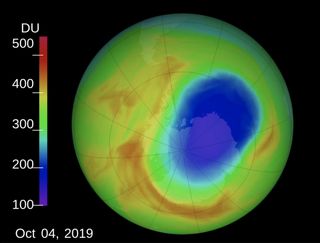Ozone Hole Over Antarctica Shrinks to Record-Small Size
It hasn't been this small since it was discovered.

The ozone hole above Antarctica, where the sun's harmful ultraviolet (UV) rays bust through an otherwise sunscreened stratosphere, has shrunk to its smallest size on record going back to 1982, scientists have found.
Typically, at this time of year, the hole in the ozone — a layer made up of molecules containing three oxygen atoms — grows to about 8 million square miles (20 million square kilometers), NASA said. That's bigger than Russia.
But unusually warm weather in the Southern Hemisphere means that the hole only extended less than 3.9 million square miles (10 million square kilometers) for most of September until now, according to a statement from NASA.
Related: 8 Ways Global Warming Is Already Changing the World
"This warming that occurred is great news for the Southern Hemisphere because ozone is going to be higher and UV levels will be lower," Paul Newman, chief scientist for Earth Sciences at NASA's Goddard Space Flight Center in Greenbelt, Maryland, told Live Science.
Here's how it works: During the winter months in the Southern Hemisphere, clouds form in the stratosphere, which extends from about 6 to 31 miles (9.5 to 50 km) above Earth's surface. There, even the smallest amount of visible light from the sun breaks apart chlorine gas into chlorine atoms; those atoms are considered "reactive" and can chemically destroy ozone molecules. So, the ozone hole over Antarctica tends to be much bigger in the southern winter.
When temperatures over Antarctica start to warm up, the polar clouds in the stratosphere dissipate, meaning that there's no place for those ozone-annihilating chemical reactions to take place. This year, exceptionally warm weather put the nix on ozone-smashing, keeping that ozone hole super-small.
Sign up for the Live Science daily newsletter now
Get the world’s most fascinating discoveries delivered straight to your inbox.
"This is as small as we were seeing back in the early '80s," Newman said. (The ozone hole was so small that it wasn't even discovered until 1985.)
The ozone-busting chlorine gas mainly comes from chlorofluorocarbons (CFCs) that were manufactured until the U.S. ban beginning in 1996. Even so, some types of CFCs can stay in the atmosphere for more than 100 years, Newman said.
If higher temperatures are good for the ozone layer, does that mean that hole will get even smaller as humans pump greenhouse gases like carbon dioxide into the atmosphere?
Not quite, Newman said. Turns out, carbon dioxide has the opposite effect in the stratosphere as it does in the layer closer to the ground called the troposphere. The CO2 in the stratosphere absorbs and then emits that heat out into space, Newman explained, adding that this layer of the atmosphere is actually cooling off.
- Images of Melt: Earth's Vanishing Ice
- In Photos: Antarctica's Larsen C Ice Shelf Through Time
- Icy Images: Antarctica Will Amaze You in Incredible Aerial Views
Originally published on Live Science.

Jeanna Bryner is managing editor of Scientific American. Previously she was editor in chief of Live Science and, prior to that, an editor at Scholastic's Science World magazine. Bryner has an English degree from Salisbury University, a master's degree in biogeochemistry and environmental sciences from the University of Maryland and a graduate science journalism degree from New York University. She has worked as a biologist in Florida, where she monitored wetlands and did field surveys for endangered species, including the gorgeous Florida Scrub Jay. She also received an ocean sciences journalism fellowship from the Woods Hole Oceanographic Institution. She is a firm believer that science is for everyone and that just about everything can be viewed through the lens of science.
Most Popular

